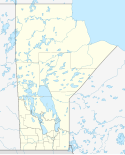Native Map Seventeen Rivers beyond Churchill 1719 (1969)
"Knight, James. Native Map Seventeen Rivers beyond Churchill Post - 1719 [facsimile]. [1:5068,800]. In: John Warkentin and Richard I. Ruggles. Manitoba Historical Atlas : a Selection of Facsimile Maps, Plans, and Sketches from 1612 to 1969. Winnipeg: Historical and Scientific Society of Manitoba, 1719, p. 86. As reproduced by, Winnipeg: Historical and Scientific Society of Manitoba.
Hudson Bay Company factors received a great deal of geographic information from the Indians who came to the posts, as well from Company servants who traveled inland. Governor James Knight of York Fort took great interest in gathering facts and ideas about the western interior which he entered in his daily post journal, and transmitted to London in his regular reports. These were, however, never collated by knight into a treatise on Western Geography. This map, sent to the Governors of the Company by the York factor, is an example of the concepts current at the time. The idea of 17 rivers beyond Churchill was given to Knight in 1716 by Northern Indians who returned with William Stewart from a long overland journey northwest of the Barren Grounds. The map depicts the Bay coast from the mouth of the Churchill river and the Arctic coast to the mouth of the Coppermine river, but the change in cardinal direction on the ocean coast is not delineated, and Boothia and Melville peninsular projection unknown, and therefore is unrevealed. The simplified, child-like forms of the rivers and the lakes indicate an indigenous source originally. The original sketch was made by Knight, but at a later date information was added concerning Captain Middleton%u2019s journey north to Wager inlet in 1741-42. Aspects of Indian life are inserted as symbols and annotations, such as the tract followed by Indians coming to and from Prince of Wales Fort from the far interior. On this map Northern Manitoba is only incidental to the main region of concern, that is the Barren Grounds tributary to the post at the mouth of the Churchill. (Warkentin and Ruggles. Historical Atlas of Manitoba. map 32, p. 86)
Map prepared in black ink by R.I. Ruggles, from original manuscript (map G. 1/19) in the Archives, Hudson's Bay Company, London. Manuscript map drawn in black ink on medium-weight paper. Drawn for James Knight by several Northern Indians. "
- Dieses Werk darf von dir
- verbreitet werden – vervielfältigt, verbreitet und öffentlich zugänglich gemacht werden
- neu zusammengestellt werden – abgewandelt und bearbeitet werden
- Zu den folgenden Bedingungen:
- Namensnennung – Du musst angemessene Urheber- und Rechteangaben machen, einen Link zur Lizenz beifügen und angeben, ob Änderungen vorgenommen wurden. Diese Angaben dürfen in jeder angemessenen Art und Weise gemacht werden, allerdings nicht so, dass der Eindruck entsteht, der Lizenzgeber unterstütze gerade dich oder deine Nutzung besonders.
| Diese Bilddatei wurde ursprünglich auf Flickr durch Manitoba Historical Maps in https://www.flickr.com/photos/11496488@N07/2106541142 hochgeladen. Sie wurde am 23. November 2009 durch den FlickreviewR-Bot geprüft und die Lizenzierung der Datei unter den Bedingungen von cc-by-2.0 wurde bestätigt. |
originally posted to Flickr as Native Map Seventeen Rivers beyond Churchill 1719 (1969)
- Uploaded using F2ComButton
Relevante Bilder
Relevante Artikel
Fort Prince of WalesDas Prince of Wales Fort ist eine 1717 errichtete Befestigungsanlage an der Hudson Bay in der heutigen kanadischen Provinz Manitoba und heute eine National Historic Site of Canada. Die Rekonstruktion des Forts aus den 1930er Jahren liegt am ursprünglichen Ort der Festung, also von Churchill aus gesehen jenseits des Churchill River. Militärisch und ökonomisch war die Festung zwar ein Fehlschlag, doch beeinflusste sie im 18. Jahrhundert die Lebensweise der dortigen Indianer, vor allem der Cree, in geringerem Maße auch der Inuit, in weitem Umkreis. .. weiterlesen





